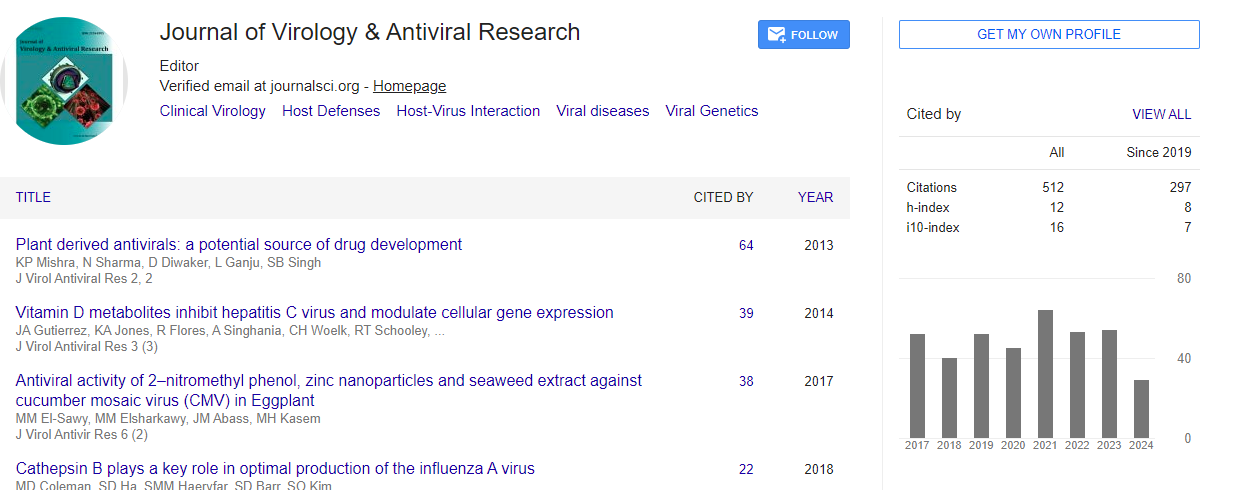Commentary, J Virol Antivir Res Vol: 13 Issue: 1
Genetic Diversity: Understanding Viral Quasi Species
Charlene Malouf*
1Department of Infectious and Inflammatory diseases, University of Toulouse, Toulouse, France
*Corresponding Author: Patrick Lanier,
Department of Infectious and Inflammatory diseases, University of Toulouse,
Toulouse, France
E-mail: cecile.malnou@univ.tlse3.fr
Received date: 26 February, 2024, Manuscript No. JVA-24-136891;
Editor assigned date: 28 February, 2024, PreQC No. JVA-24-136891 (PQ);
Reviewed date: 14 March, 2024, QC No. JVA-24-136891;
Revised date: 22 March, 2024, Manuscript No. JVA-24-136891 (R);
Published date: 28 March, 2024, DOI: 10.4172/ 2324-8955.1000696
Citation: Malouf C (2024) Genetic Diversity: Understanding Viral Quasi Species. J Virol Antivir Res 13:1.
Description
Viral quasi species, characterized by the presence of genetically diverse viral variants within a population, play a fundamental role in viral evolution, pathogenesis, and antiviral resistance. This manuscript provides a comprehensive overview of viral quasi species dynamics, encompassing the mechanisms driving quasi species formation, the impact of genetic diversity on viral fitness and adaptation, and the implications for disease progression and therapeutic interventions. By integrating genomic analyses and computational modelling, we unravel the intricate dynamics of viral quasi species, shedding light on their role in viral pathogenesis and evolution. Viral quasi species represent a dynamic population structure characterized by the presence of genetically diverse viral variants within a single infected host. Quasi species dynamics arise from the high mutation rates and replication fidelity of RNA viruses, which enable rapid generation of genetic diversity and selection of advantageous variants in response to environmental pressures. This manuscript explores the multifaceted dynamics of viral quasi species, from the mechanisms driving quasi species formation to their implications for viral evolution, pathogenesis, and therapeutic interventions.
Mechanisms of viral quasi species formation
Viral quasi species arise from the error-prone nature of viral replication, driven by the activity of viral polymerases with limited proofreading capacity. During replication, mutations accumulate in the viral genome, generating a heterogeneous population of closely related variants known as the quasi species cloud. High mutation rates, population bottlenecks, and selective pressures shape the composition and diversity of viral quasi species, allowing for rapid adaptation to changing environments. Furthermore, recombination events and complementation between viral variants contribute to the genetic diversity and complexity of quasi species populations.
Impact of genetic diversity on viral fitness and adaptation
Genetic diversity within viral quasi species confers several advantages, including increased adaptability to diverse environments, enhanced evasion of host immune responses, and greater resistance to antiviral therapies. Quasi species diversity enables exploration of sequence space, facilitating the acquisition of mutations that confer fitness advantages, such as enhanced replication capacity or altered antigenicity. Moreover, genetic diversity within quasi species provides a reservoir of variants that can serve as substrates for selection under changing conditions, allowing viruses to exploit new ecological niches and evade host defenses.
Implications for disease progression and therapeutic interventions
Viral quasi species dynamics have profound implications for disease progression, treatment outcomes, and the emergence of drug resistance. Quasi species diversity influences viral pathogenesis by shaping viral tropism, virulence, and tissue tropism. Additionally, quasi species diversity can impact the efficacy of antiviral therapies, as treatment may select for pre-existing drug-resistant variants or promote the emergence of novel resistance mutations. Understanding the dynamics of viral quasi species is essential for optimizing antiviral treatment regimens, designing more effective vaccines, and predicting the emergence of drug-resistant viral strains.
Genomic analyses and computational modelling of viral quasi species
Genomic analyses, including Next-Generation Sequencing (NGS) and bioinformatics tools, have revolutionized our ability to characterize viral quasi species and elucidate their dynamics. NGS technologies enable high-throughput sequencing of viral genomes, allowing for the comprehensive analysis of quasi species diversity and evolution. Computational modelling approaches, such as population genetics models and phylogenetic analyses, provide insights into the dynamics of quasi species formation, selection, and adaptation. Integration of genomic data and computational modelling allows for a deeper understanding of viral quasi species dynamics and their role in viral evolution and pathogenesis.
Conclusion
In conclusion, the study of viral quasi species dynamics provides a window into the complex and dynamic nature of viral populations within infected hosts. Through the lens of quasi species theory, we have gained valuable insights into the mechanisms underlying viral evolution, adaptation, and pathogenesis. The high mutation rates and replication fidelity of RNA viruses give rise to diverse quasi species clouds, which act as reservoirs of genetic diversity and fuel the ongoing arms race between viruses and their hosts. Quasi species diversity has profound implications for viral fitness, virulence, and the efficacy of antiviral therapies. The interplay between genetic variants within quasi species populations shapes viral tropism, immune evasion strategies, and the emergence of drug-resistant strains. Understanding these dynamics is essential for devising effective strategies to combat viral infections, develop novel antiviral therapies, and design vaccines that elicit broad and durable immune responses.
 Spanish
Spanish  Chinese
Chinese  Russian
Russian  German
German  French
French  Japanese
Japanese  Portuguese
Portuguese  Hindi
Hindi 

